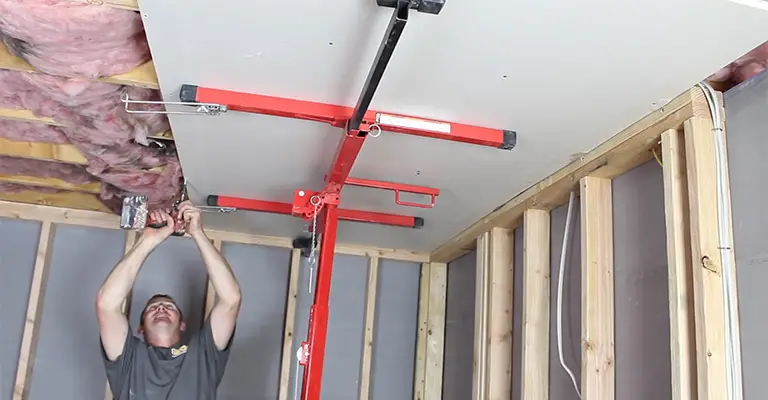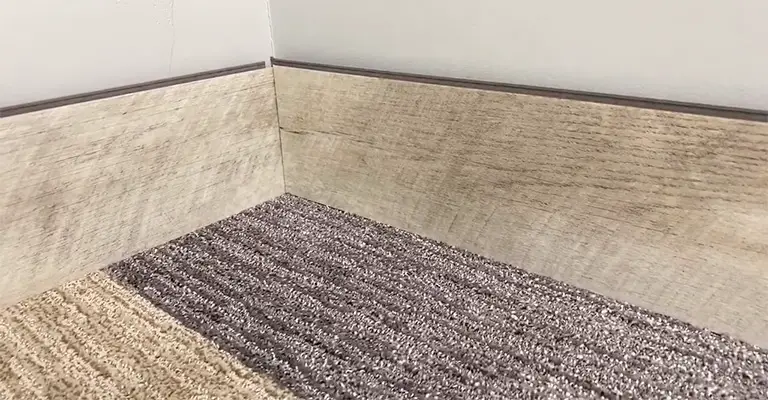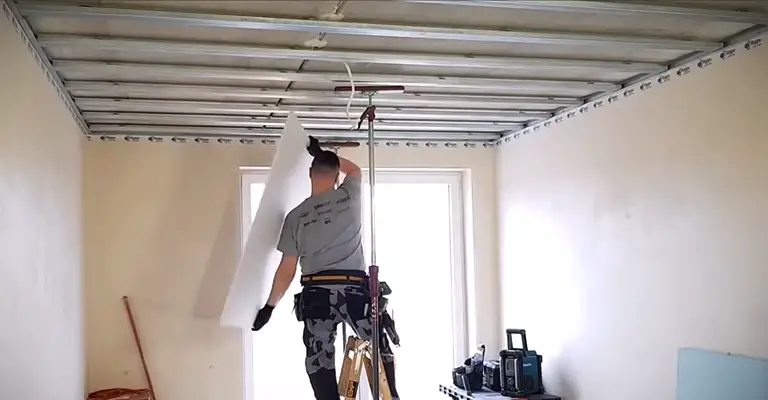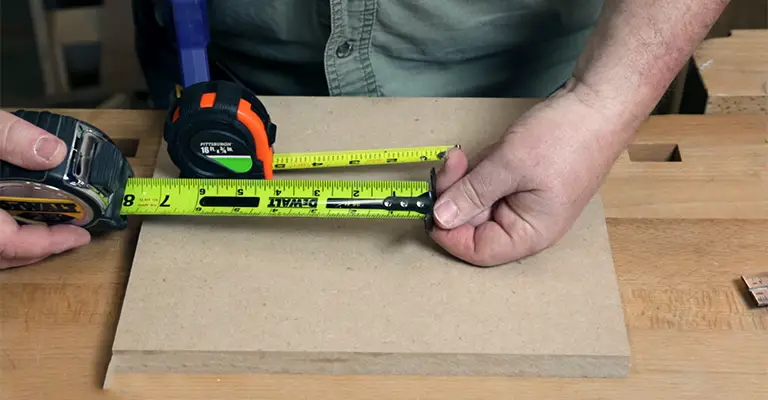Drywall is a common building material for many walls and ceilings. Installing and working with it is easy.
Because it results in clean finishes, is highly durable, and requires little work and effort to maintain, it is highly recommended. You should follow some tips to install it properly for the best results.
It is always best to hang the ceiling first when hanging drywall. It is hard to hang this drywall by yourself, so get a partner and take your time. For several reasons, you should install drywall on the ceiling before you build the walls:
- It is easier to work with the pieces from the top since they are smaller and faster.
- With tight and fitted corners, you can create a better look.
- The drywall can hold up a ceiling piece on the walls.
It is challenging to repair large cracks caused by misaligned sheets because the extra mud needed to fill them will constantly fall into the floor (or worse, down your back!).
It is best to hang the top sheet of drywall first when hanging drywall on the walls. At each stud, attach a drywall nail at the top and bottom of the sheet and raise it tight to the ceiling.
Before proceeding to the bottom row, complete the top row in the entire room. By hanging the drywall on the ceiling first, you will achieve a better-quality result that will require fewer repairs in the future.
When you install the materials properly the first time, you’ll have an easier time managing them. Contractors have been hanging drywall on ceilings first for a long time since it has proven to result in a successful project.
Why Should You Hang Drywall On The Ceiling Before The Walls?
Ceilings and walls are constructed of dry drywall, which is the main component of the foundation. A strong and reliable foundation and construction will prevent damage and maintain its structural integrity.
Your choice of the order in which you install this drywall will significantly impact its durability and reliability. Before you start installing the walls, you need to install drywall on the ceiling:
1. Simpler and Faster Work Experience

It can be challenging to work above your head when you are trying to fix the ceiling. You will have an easier time with the rest of the process if you start here.
In addition to being able to fit everything tightly, you can work with the sheet in front of you instead of over your head. As you work your way down, you can adjust the sizing by starting at the top and covering the largest surface area.
Assuring a good fit is easiest by pushing the drywall snugly against the ceiling and then dealing with the left-over gaps. You may not know how much space to leave from the bottom since the baseboards will cover it.
2. Tight and Clean Corners

Putting the wall pieces up against the ceiling drywall ensures an even greater level of support and an aesthetically pleasing finish. Many tips are available for installing drywall corners that are known to be tricky.
You may want to have clear edges and corners in the drywall because it is the outermost layer in the room. By pushing the wall pieces against the ceiling, inconsistencies, and gaps are eliminated.
Although these pieces should be tight against each other, make sure the joints are not overly tight. The drywall can become damaged if it is too tightly screwed together:
- Cracks: If you have too much support, especially regarding frame changes, you can cause negative pressure to build. These factors can cause external warping and cracking of drywall.
- Cause complete breaks: Depending on the season, wood stretches and contracts within the frame. You can imagine these as tectonic plates that might rub against one another.
To avoid these problems, make sure your sheets have enough space between them. An eighth-inch space is recommended; you can measure this using a ruler.
It is still possible to maintain a clean, tight, tight look and support without adding extra strain to the ceiling pieces.
3. Increased Ceiling Support

Installing drywall begins with the ceiling pieces first, mainly because they provide additional support. Attaching the ceiling sheets first will reinforce them with the wall pieces, providing stability.
In the process, the ceiling sheets will be pushed into place more and more until they can put pressure on the wall pieces.
Despite screws and taping holding the ceiling in place, the drywall shouldn’t solely depend on them. A crack may form when these adhesions are stressed over time by the weight of the drywall.
There is typically cracking and breakdown around the edges when this occurs. The good thing is that the wall pieces will be placed at the edges to prevent this from happening.
During installation, gravity relieves some of the pressure on the ceiling drywall caused by wall pieces being placed against it. Gravity feels less of an impact by securing the wall pieces vertically with their own fasteners and taping.
A thick insulation layer on top of the ceiling or another floor can significantly affect the drywall’s strength.
Support is especially important when there is another floor, attic, or even additional weight above the ceiling. This article provides further information on the importance of that support.
As much support as possible should be provided to keep the ceiling intact and intact. One of the best ways to provide strong support is to reinforce the ceiling drywall with the walls.
Measurement Tips

If the bottom sheet needs to be cut to fit around electrical j-boxes and plumbing rough-ins, then do so during the hanging process. Calculate (to the nearest 1/8 inch) the horizontal dimensions of the box, measured from left to right.
The exact location of the mark should be noted on the drywall, from left to right. Trace these marks onto the surface with a pencil and a four-foot drywall square. Don’t measure vertically from the floor, but rather from the floor down.
Do not measure down from the top of the already-hung drywall. Instead, start measuring from the bottom.
Measuring from top to bottom, transfer this measurement. By cutting the drywall along your layout marks, you will be able to accommodate the junction box once you have a layout for what you will remove.
You must mark the locations of each stud on the subfloor before you lay the drywall against the wall. The drywall will be easier to nail or screw with this method.
Make sure your bottom sheet fits snugly against the bottom edge of the top drywall you have already hung. It is extremely helpful to use a wallboard kicker when lifting wallboards.
The drywall sheet is now tight and fits your junction box. Attach the drywall top and bottom by using drywall nails.
Tips For Installing Drywall
Installing drywall can be a challenging task, but with the right tools and techniques, you can achieve a smooth and professional-looking finish. Here are some tips to help you install drywall:
- Measure and plan carefully: Measure the area to be covered with drywall carefully and plan your installation strategy. Cut your drywall pieces to fit the space and label them accordingly.
- Use the right tools: Use a drywall screw gun or drill to drive the screws into the drywall. A T-square, straight edge, and a utility knife are also essential tools to cut the drywall.
- Install the drywall horizontally: Install the drywall horizontally, with the long edges of the sheets running parallel to the floor. This makes it easier to conceal the seams later on.
- Use screws, not nails: Use drywall screws rather than nails to attach the drywall to the studs. Screws are stronger and less likely to pop out or cause cracks in the drywall over time.
- Apply joint compound: Apply joint compound to the seams between the drywall sheets with a drywall knife, using thin layers and feathering the edges to create a smooth finish.
- Sand the joints: Sand the joints between the drywall sheets to smooth out any rough spots or bumps.
- Prime and paint: Prime the drywall before painting to ensure the paint adheres well to the surface.
Remember to work carefully and take your time to ensure a professional-looking finish.
Final Words
To ensure better structural quality, maintain a finished look, and make drywall installation easier, ceiling drywall should be installed before wall pieces.
The easiest (and cheapest) way to install drywall is to do it correctly from the beginning, so you don’t have to make unnecessary repairs later!






